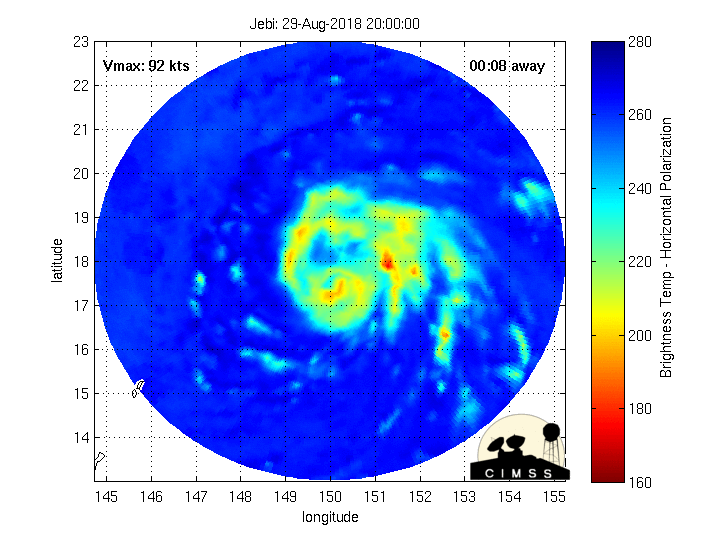Super Typhoon Jebi
West Pacific Typhoon Jebi underwent a period of very rapid intensification on 30 August 2018 (ADT | SATCON), reaching Category 5 Super Typhoon intensity. Himawari-8 rapid-scan (2.5 minute interval) “Clean” Infrared Window (10.4 µm) images (above) showed that Jebi began to exhibit an annular appearance with a nearly symmetric eyewall as it moved through the Northern Mariana Islands (north of Guam). The eye passed just south of the uninhabited volcanic island of Pagan around 16 UTC on 30 August.Himawari-8 “Red” Visible images (below) revealed mesovortices within the eye of Jebi.
Toggles between VIIRS Day/Night Band (0.7 µm) and Infrared Window (11.45 µm) images from NOAA-20 and Suomi NPP (below) showed more detailed views of (1) the well defined eye, (2) surface mesovortices within the eye, and (3) storm-top gravity waves that were propagating away from the eyewall region. With the Moon in the Waning Gibbous phase (at 77% of Full), ample illumination was available to provide detailed “visible images at night” using the VIIRS DNB.![NOAA-20 Day/Night Band (0.7 µm) and infrared Window (11.45 µm) images at 1602 UTC [click to enlarge]](https://cimss.ssec.wisc.edu/satellite-blog/wp-content/uploads/sites/5/2018/08/180831_1602utc_noaa20_viirs_DayNightBand_InfraredWindow_Jebi_anim.gif)
NOAA-20 VIIRS Day/Night Band (0.7 µm) and infrared Window (11.45 µm) images at 1602 UTC [click to enlarge]
![Suomi NPP VIIRS Day/Night Band (0.7 µm) and infrared Window (11.45 µm) images at 1652 UTC [click to enlarge]](https://cimss.ssec.wisc.edu/satellite-blog/wp-content/uploads/sites/5/2018/08/180831_1652utc_SuomiNPP_viirs_DayNightBand_InfraredWindow_Jebi_anim.gif)
Suomi NPP VIIRS Day/Night Band (0.7 µm) and infrared Window (11.45 µm) images at 1652 UTC [click to enlarge]
In a comparison of DMSP-16 SSMIS Microwave (85 GHz) and Himawari-8 Infrared Window (10.4 µm) images at 1900 UTC (below), the Microwave data helped to better visualize the structure of the large eyewall in addition to a long, narrow feeder band wrapping inward toward the eye.


![GCOM-W2 AMSR2 Convective Rain Rate and Surface Rain Rate products [click to enlarge]](https://cimss.ssec.wisc.edu/satellite-blog/wp-content/uploads/sites/5/2018/08/180831_1645utc_gcom_amsr2_ConvectiveRainRate_SurfaceRainRate_Jebi_anim.gif)
![Track of Jebi, with Sea Surface Temperature and Ocean Heat Content [click to enlarge]](https://cimss.ssec.wisc.edu/satellite-blog/wp-content/uploads/sites/5/2018/08/180831_sst_ohc_Jebi_anim.gif)

![DMSP-16 SSMIS Microwave (85 GHz) and Himawari-8 Infrared Window (10.4 µm) images [click to enlarge]](https://cimss.ssec.wisc.edu/satellite-blog/wp-content/uploads/sites/5/2018/08/180831_1900utc_dmsp16_microwave_himawari8_infrared_Jebi_anim.gif)